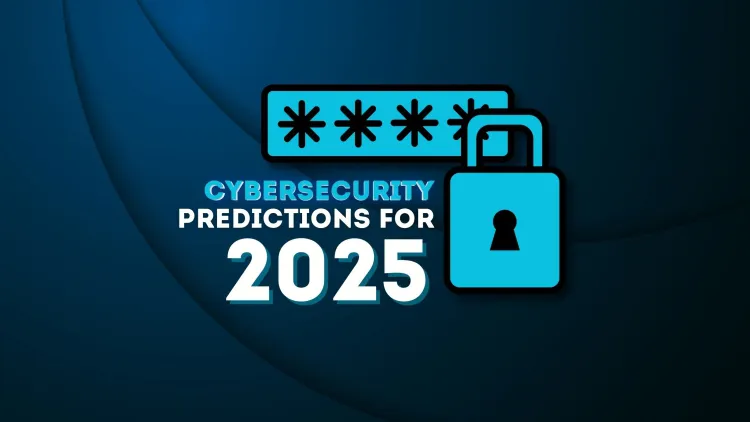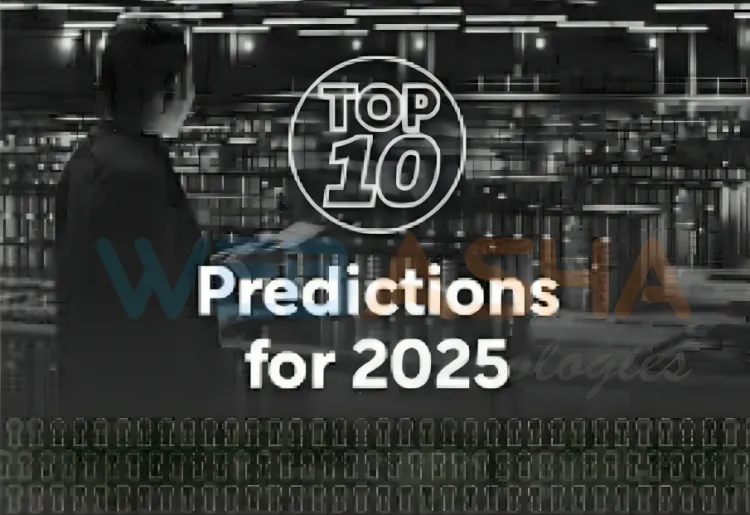Cybersecurity Predictions for 2025 | Emerging Threats, AI Challenges, and the Rise of Virtual CISOs
The cybersecurity landscape in 2025 is expected to see key shifts driven by emerging threats and technological advancements. AI adoption will slow down due to budget constraints and its limited impact on incident response. Meanwhile, AI guardrails will be emphasized to secure AI-generated code and create proactive policies. The rise of Initial Access Brokers (IABs) will lower barriers to cybercrime, making it easier for novice attackers to execute ransomware and other attacks. Organizations will increasingly rely on Managed Service Providers (MSPs) and Managed Security Service Providers (MSSPs) due to skill shortages and the complexity of managing nonhuman identities like IoT devices. Tech rationalization will help streamline security operations and reduce tool overload. Persistent threats and long-term cyberattacks will require improved resilience strategies. Attacks on open-source software will rise, prompting the need for better security testing and software vetting. Cloud visibilit

Cybersecurity continues to evolve, and 2025 promises to bring significant changes. From the increasing prominence of initial access brokers (IABs) to the growing reliance on virtual CISOs (vCISOs), here are the top predictions that will shape the cybersecurity landscape.

1. CISOs Step Back from AI Adoption
In 2024, AI was a major focus area, but 2025 may see a 10% reduction in its adoption for cybersecurity purposes.
Why Is AI Adoption Slowing?
-
Budget Constraints: Many organizations lack the resources to invest in advanced AI tools.
-
Limited Impact on Incident Response: While AI automates tasks like reporting and analysis, it hasn’t significantly enhanced incident response capabilities.
-
Frustration with Current AI Models: Some security teams find AI tools overly complex or insufficiently tailored to their needs.
What This Means for Organizations
Organizations should carefully evaluate the benefits of AI tools before implementation and focus on areas where AI can deliver measurable results, such as threat detection and automation of repetitive tasks.
2. Pressure to Place Guardrails Around AI
As AI adoption continues across industries, there is increasing pressure to develop regulations ensuring its safe use.
Key Focus Areas for AI Guardrails
-
Securing AI-Generated Code: Protecting applications from vulnerabilities introduced during AI-assisted development.
-
Proactive Policies: Creating internal policies to govern how AI tools are used within the organization.
Security teams must work closely with developers and policymakers to establish clear guidelines for AI usage.
3. Prepare for the Rise of Initial Access Brokers (IABs)
Initial Access Brokers are becoming more prevalent in the cybercrime ecosystem. These actors specialize in breaching networks and selling access to other threat groups.
| Aspect | Details |
|---|---|
| Definition | Threat actors selling access to networks. |
| Key Statistics (Oct 2024) | Nearly 400 IAB listings were recorded. |
| Impact | Lowers the barrier for executing ransomware and other attacks. |
Why Are IABs Significant?
-
Enables Novice Attackers: Threat actors no longer need advanced technical skills to breach organizations.
-
Accelerates Cybercrime: Access-as-a-service shortens the time to launch attacks, increasing overall risk.
How to Mitigate This Threat
-
Implement multi-factor authentication (MFA) to secure access points.
-
Regularly monitor for unauthorized access and conduct penetration testing.
-
Collaborate with threat intelligence providers to stay updated on emerging IAB activities.
4. Reliance on MSPs and MSSPs Increases
With the growing complexity of cybersecurity, organizations are turning to Managed Service Providers (MSPs) and Managed Security Service Providers (MSSPs) for support.
Why MSPs and MSSPs Are Critical
-
Skill Shortages: Many organizations lack in-house expertise to manage advanced threats.
-
Nonhuman Identity Explosion: Nonhuman identities, such as IoT devices and APIs, outnumber human identities 50-to-1. Managing these requires specialized skills.
How MSSPs Add Value
-
Centralized management of security tools.
-
Advanced threat detection and response capabilities.
-
Continuous monitoring of nonhuman identities.
5. Time for Tech Rationalization
Many security teams face tool overload, with an average of over 30 tools in their stacks. This can lead to inefficiencies and increased costs.
What Is Tech Rationalization?
Tech rationalization involves evaluating and optimizing an organization’s security tools to eliminate redundancies and improve efficiency.
| Evaluation Criteria | Questions to Ask |
| Relevance | Does this tool address current and future security needs? |
| Integration | How well does it integrate with existing tools? |
| Cost Efficiency | Can its functions be handled by existing tools at a lower cost? |
| Vendor Roadmap | Are future features aligned with organizational goals? |
Benefits of Tech Rationalization
-
Reduces operational complexity.
-
Saves costs by eliminating unnecessary tools.
-
Streamlines security operations.
6. Attackers Show More Patience Before Striking
Long-term cyberattacks, such as the Volt Typhoon campaign, are expected to increase. These attacks involve gaining access and lying dormant for extended periods.
Why Are Persistent Threats Dangerous?
-
Difficult to Detect: Attackers can remain undetected for years.
-
Strategic Timing: Threat actors can strike when the impact will be most severe.
Defense Strategies
-
Focus on cyber resilience rather than prevention.
-
Implement microsegmentation and macrosegmentation to limit lateral movement within networks.
-
Continuously monitor for anomalies that might indicate dormant threats.
7. Rise in Open Source Software Attacks and Legislation
Open source software is increasingly targeted by attackers, with over 500,000 malicious packages identified since late 2023.
Why Open Source Is Vulnerable
-
Unvetted Components: Many organizations use open source code without proper security checks.
-
Developer Knowledge Gaps: Not all developers are trained in secure coding practices.
Mitigation Measures
| Measure | Action |
| Request Software BOMs | Understand software components. |
| Conduct Security Testing | Fuzzing, source code analysis, and scanning. |
| Report Issues | Share vulnerabilities with the community. |
Additionally, governments worldwide are working on regulations to improve the security of open source software.
8. Lack of Visibility Across Clouds Hurts Organizations
Cloud adoption has created visibility challenges, especially in multi-cloud environments. Many organizations rushed to the cloud during the pandemic without proper planning, leading to security gaps.
Addressing Cloud Visibility Issues
-
Invest in cloud security posture management tools.
-
Conduct regular audits to identify and address visibility gaps.
-
Implement data classification to monitor and secure sensitive information.
9. Rise in vCISOs and CSO Consultants
Virtual CISOs (vCISOs) are becoming popular as organizations seek cost-effective cybersecurity leadership.
Why vCISOs Are in Demand
-
Cost Efficiency: Ideal for organizations that cannot afford a full-time CISO.
-
On-Demand Expertise: vCISOs provide strategic guidance and periodic assessments.
Example Use Case
An organization hires a vCISO to draft its annual cybersecurity strategy and conducts quarterly reviews to ensure alignment with evolving threats.
10. AI Agents Become Targets of Compromise
AI agents, designed for tasks like customer support and workflow automation, are increasingly targeted by attackers.
Types of AI Agent Attacks
-
Prompt Injection Attacks: Manipulating AI agents to perform unauthorized actions.
-
Data Leakage: Exploiting AI agents to reveal sensitive information.
Securing AI Agents
-
Conduct vulnerability assessments specific to AI agents.
-
Classify data to control what AI agents can access.
-
Adapt existing security playbooks to include AI-specific risks.
Conclusion
The cybersecurity landscape in 2025 will be shaped by both emerging threats and evolving technologies. Organizations must remain proactive, focus on resilience, and leverage innovative strategies to navigate these challenges effective.
FAQs
-
What are Initial Access Brokers? IABs are entities that sell access to compromised networks, enabling threat actors to execute attacks.
-
Why is AI adoption slowing down in cybersecurity? Budget constraints and limited incident response benefits are key reasons.
-
What is tech rationalization? It involves evaluating and optimizing an organization’s security tool stack to reduce redundancies and inefficiencies.
-
How can organizations combat open source software attacks? By conducting thorough security testing, requesting software BOMs, and sharing vulnerabilities.
-
What are the benefits of hiring a vCISO? vCISOs provide cost-effective, on-demand strategic guidance for organizations without a full-time CISO.
-
What are prompt injection attacks? These are attacks where threat actors manipulate AI systems to perform unauthorized actions.
-
Why is cloud visibility important? Lack of visibility in multi-cloud environments can expose sensitive data to threats.
-
What are nonhuman identities? These include servers, IoT devices, and other digital identities that need proper management.
-
How can organizations prepare for long-term attacks? By focusing on resilience and implementing segmentation strategies.
-
What role will MSSPs play in 2025? MSSPs will provide expertise and resources to manage expanding security needs, particularly for nonhuman identities.












![Top 10 Ethical Hackers in the World [2025]](https://www.webasha.com/blog/uploads/images/202408/image_100x75_66c2f983c207b.webp)

![[2025] Top 100+ VAPT Interview Questions and Answers](https://www.webasha.com/blog/uploads/images/image_100x75_6512b1e4b64f7.jpg)









